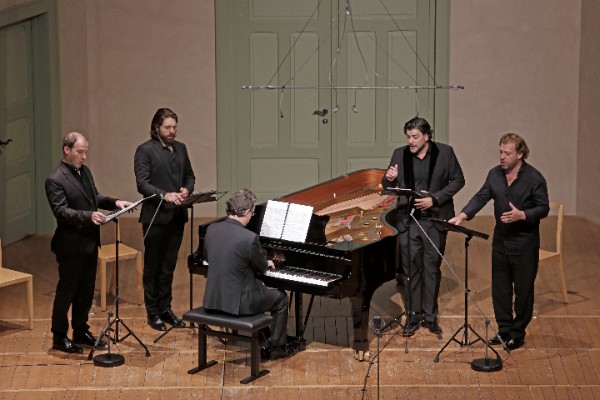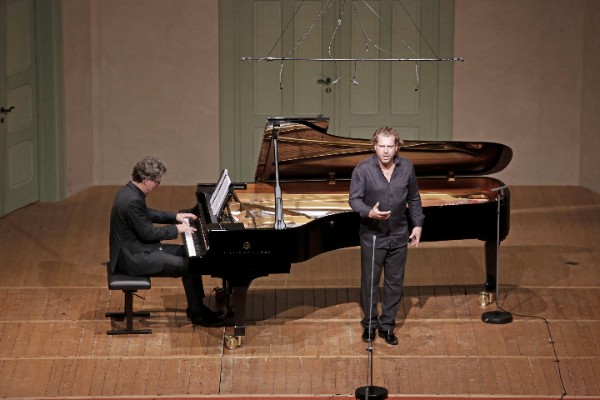Greek National Opera’s revival of Katie Mitchell’s production for the Royal Opera House, Covent Garden, is based around the idea of a split stage. This idea sometimes worked and other times was just a distraction. Singing would take place on one half, and background action, sometimes helpful and sometimes distracting, took place silently in the other half.
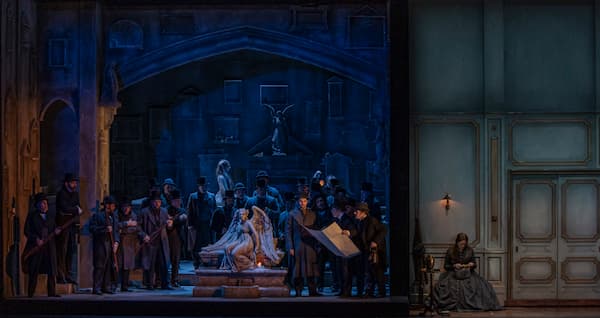
Lucia di Lammermoor, Act I, scene I: Searching for Edgardo (left), Lucia reading Edgardo’s letter (right), 2025 (GNO) (Photo by A. Simopoulos)
Greek National Opera’s revival of Mitchell’s 2016 work took her ideas of pushing a female point of view and made some interesting headway with it. It wasn’t completely successful because of Donizetti and his librettist, Salvatore Cammarano (and Sir Walter Scott before him), and the emphasis on the machinations of men. However, Lucia and her maid do their best to meet this. Following the scene shown above, Lucia and her maid don men’s clothes to make the assignation with Edgardo.
It’s pure melodrama and the dark tale of the Ravenswood and Ashton families, separated by lawsuits and illicitly joined in love, is the core of the tragedy. Lucia Ashton falls in love with Edgardo Ravenswood, yet her brother needs her to marry Arturo Bucklow to save the family fortunes. But, she’s already engaged herself to Edgardo (and has the ring to show it). No matter, Edgardo is now off in France, his letters to Lucia are intercepted, and false letters indicating that he’s fallen in love with another convinces Lucia to give her consent to the marriage to Arturo. Of course, the minute she signs the betrothal document, Edgardo turns up and is nasty to Lucia for being unfaithful, rather than figuring out that she’s just been manipulated into her unhappy position. Lucia must go through with the wedding…but she has plans on how to put an end to the situation.
In the conventional Lucia, she turns up at the wedding celebration covered in the blood of her now deceased bridegroom. In this Lucia, she’s in a slightly different situation. We’ve learned in the first act that she has truly committed to Edgardo to the point that she is pregnant, as we are informed in silent play on the right side of the stage when she suffers morning sickness and then pats her tummy to show she understands the reason. With the help of her maid Alisa, Lucia has killed Arturo, disabling him first with a suffocating pillow held by Alisa, and then dispatches him with a handy knife she’d previously stashed under the bedclothes. It could have gone all Grand Guignol, with sprays of blood everywhere, but she emerges still clothed in pristine white…until she has her miscarriage and blood runs everywhere, but only from the waist down.
Meanwhile, Edgardo and Lucia’s manipulating brother Enrico are to meet in a duel, but although Enrico knows of Lucia’s action, Edgardo is still imagining Lucia and her wedding night with another man. When he learns of her action and ensuing madness, he runs off to find her, but she has committed suicide in her bath. (One of the great audio idiocities of the production was the decision to have the sound of running water over the final scene – it wasn’t needed and made the audience wonder if something had gone wrong with the plumbing on stage.) Edgardo slits his own wrists, and finding that not quick enough, cuts his own throat.
The ghosts. Two ghosts figure in this production of the opera – one who was killed an early Ravenswood and appears wearing 18th-century-style clothing, with panniers (side hoops), and another who is probably Lucia’s recently deceased mother. They glide through the scenes, seen only by Lucia (and, the presumably mad) audience. In her mad scene, as Lucia is looking for Edgardo to be her bridegroom, he turns up as a ghost, being seen as a ghost by the sole effect of removing his shoes and socks.
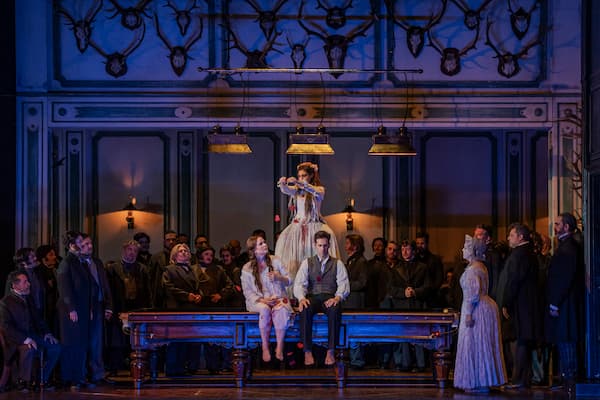
Lucia di Lammermoor, Act II, scene 2: Edgardo as a ghost (note feet), with the First Ghost behind them, and the second ghost to the right, 2025 (GNO) (Photo by A. Simopoulos)
They could have done better on that, perhaps giving him white garb to match the other ghosts. The ghosts don’t help or hinder Lucia, they’re just there, silent and unreachable, and a bit inexplicable. Since she sees at least one of the ghosts from the very first act, we may have to assume that she was always slightly mad.
The show opened on 8 April with the first cast (Jessica Pratt, Lucia; Ismael Jordi, Edgardo; and Petros Magoulas, Raimondo); the second cast was all Greek singers (Vassiliki Karayanni, Lucia; Yannis Christopoulos, Edgardo, and Tassos Apostolou, Raimondo). Unfortunately, the night I saw it, both Vassiliki Karayanni, Lucia and Yannis Christopoulos, Edgardo, were not well. She avoided most of the highest notes, ending many of her big pieces by taking them down an octave, and he sang at half-voice, still agile, but sometimes verging on pianissimo.
Greek bass Tassos Apostolou got the loudest roar of the night. He sang Raimondo, the Calvinist chaplain who helps Enrico convince her sister to give up Edgardo. With his height, he loomed over Lucia and told her the necessary lies. This season, with GNO he’s sung Bluebeard in Bluebeard’s Castle, Colline in La bohème, and Trinity Moses in GNO’s Rise and Fall of the City of Mahagonny.
The necessary elements for a melodrama didn’t quite add up in this production. Lucia never really seemed desperate, she and Edgardo didn’t seem very enthusiastic about each other, Edgardo didn’t push either the lover or hater side of his character very far. Since no one could see the ghosts, they didn’t affect anyone else, even to the point of giving them a shiver as they passed by. Having major emotional scenes with her brother in the bathroom seemed a bit strange. This was all to introduce the MacGuffin of the tub in which she would later suicide but was really a bit wasted. This may have been part of the split stage problem – if you’re going to split the stage to show the background actions, then you have to invent something to add.
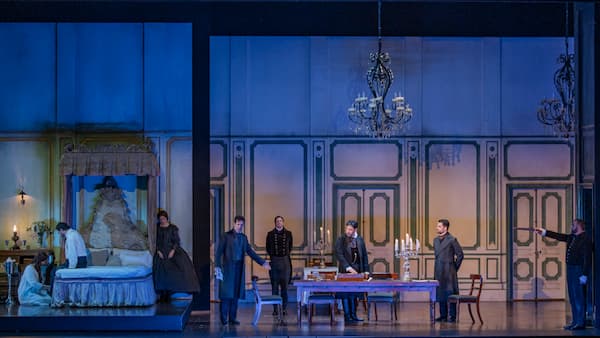
Lucia di Lammermoor, Act II, scene 1: Lucia undressing her bridegroom (left), Edgardo meeting Enrico to issue his challenge for a duel (right), 2025 (GNO) (Photo by A. Simopoulos)
What drives Lucia mad isn’t the incessant pressure from her brother and his friends to save him financially, and it isn’t the murder of her unwanted husband, it’s the loss of the one thing that was truly Edgardo’s, his baby. Of course, adding that little detail to the story gives us a less-innocent Lucia than we’ve had before, but perhaps gives us the one detail, her miscarriage, that is the clue to her sudden-onset madness. It was an interesting revival, but one that could benefit from looking at the reviews of the earlier productions to perfect this one.
Greek National Opera’s Lucia di Lammermoor Final Trailer
Greek National Opera
Donizetti: Lucia di Lammermoor
8, 10, 12, 23, 27, 29 April and 4, 11 May 2025.
For more of the best in classical music, sign up for our E-Newsletter

